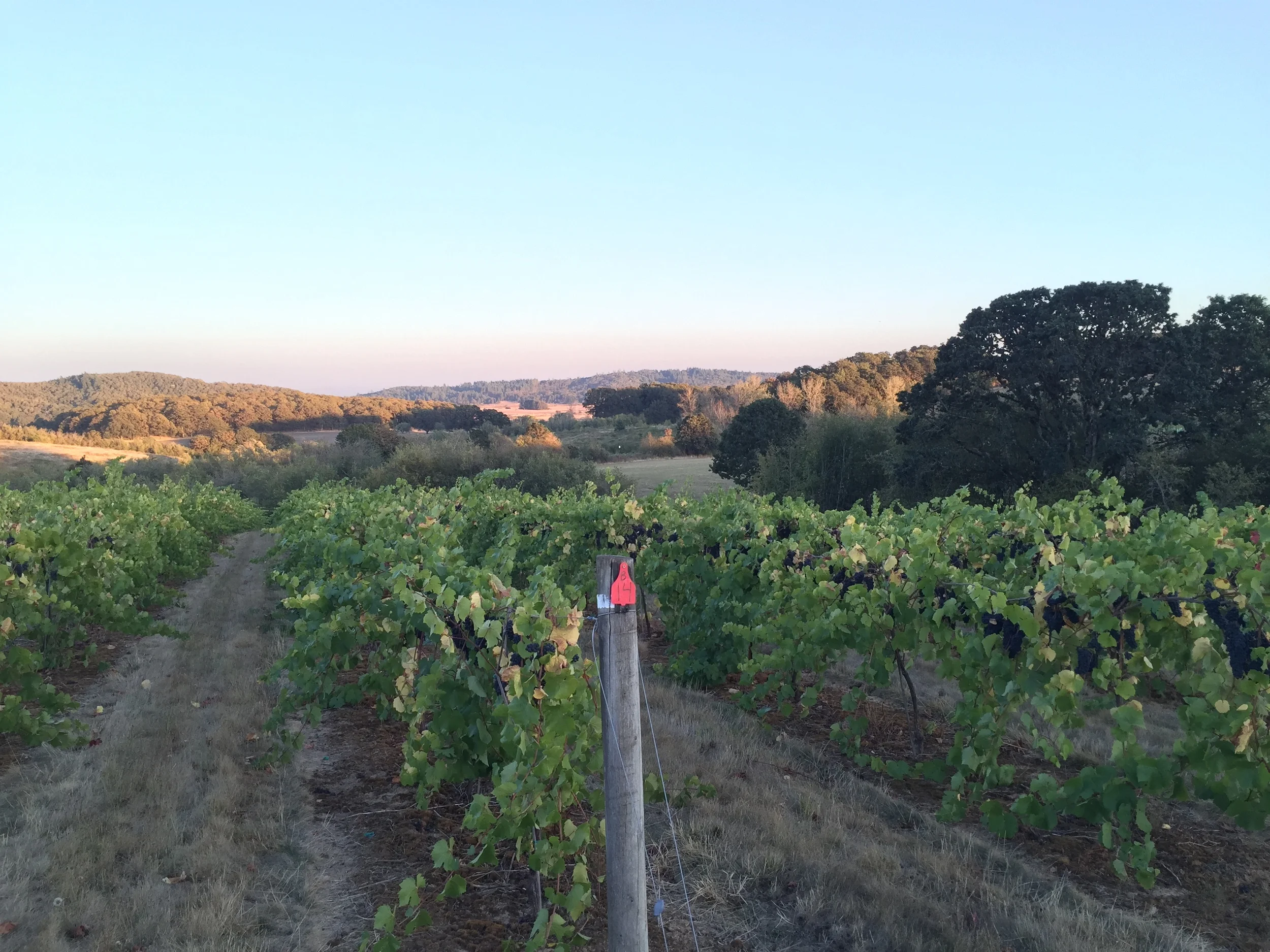No irrigation, no systemic herbicides
While I do not own any vineyards, I farm my blocks at Hanson Vineyards under a lease agreement; prior to that, I farmed Zena Springs under a similar agreement. I purchase the majority of my grapes from trusted farmers, typically under acreage contracts so that I can manage yields correctly and ensure custom farming protocols as needed.
All but one of the vineyards are located in the central Willamette Valley, right along the 45th parallel. All are dry farmed, without exception.
Hanson Vineyards
WILLAMETTE VALLEY AVA • PINOT NOIR, Pinot Gris, Pinot Blanc, Gamay
I lease vines from Jason Hanson and farm them organically, without tillage, and with 100% cover crop.
The vines at Hanson are planted on very well drained alluvial soils. A melange of clay, silt, and sand dominate the top layers, and beneath that are gravels emplaced by Butte Creek. It's an unusual terroir for the Valley, and the wines show bright acids and graceful, gentle textures. (Pinot noir, Pinot gris)
The nearby HH vineyard is sited in Missoula flood deposits; vigor is reduced through the use of cover crops and I carefully manage yields. (Pinot blanc, Gamay)
The nearby Aamodt block is planted exclusively to 40 year old own-rooted Pommard clone Pinot Noir. This steeply sloping vineyard includes both deep Woodburn silt loam and sandier alluvial soil.
Acadia Vineyards
Columbia Gorge AVA • Grüner Veltliner
Acadia is a certified organic vineyard planted high above the Columbia River at 1300' elevation on the slopes of extinct Underwood Mountain. It's the Washington side of the AVA, just a bit northwest of Hood River.
Our newest fruit source is also our first to be sited on volcanic soil. But whereas most volcanic wine growing soils in Oregon are derived from basalt lava flows, the ashy loam at Acadia is derived from pyroclastic flows. The soils seem to impart a strong core of minerality.
The vineyard is sited at the very boundary between the temperate rain forest to the west and the inland desert to the east – this is very apparent in satellite photography. The famous winds of the Columbia Gorge keep disease pressure at bay, which helps facilitate the organic farming program.
Satori Springs
Willamette Valley AVA • Blaufränkisch, Rotburger, Ehrenfelser, Kerner
Satori Springs is a west-facing site located near Oregon City. The Ehrenfelser and Kerner are the components of my “Lionesses” white blend; these varieties are planted on 2.5 million year old Jory soil formed during the eruption of nearby Highland Butte, a cinder cone that’s part of the Boring Volcanic Field. The Blaufränkisch and Rotburger are components of my “Failed Empires” red blend; these varieties are planted lower on the slope on Cornelius silt loam, a silty loess-like soil.
Zenith Vineyard
EOLA-AMITY HILLS AVA • Pinot Noir
The Pinot noir from Zenith forms the backbone of the Eola-Amity Hills bottling and a vineyard designate wine is made as well.
The vast majority of my purchased grapes come from block 9-E, which is Pommard clone planted in 2006. In vintages 2014 and 2015 I also purchased small amount of 115 clone. As of 2016, I have replaced the 115 clone with a very young block of Wadenswil clone Pinot noir.
Zenith is a LIVE-certified vineyard. Soils are marine sedimentary. The gentle, south-facing slopes are cultivated (i.e. plowed) and are never sprayed with herbicides. The compost is built primarily from materials originating on-site.
Keeler Estate Vineyard
Eola-Amity Hills AVA • Pinot Gris
Keeler Estate Vineyard is a Demeter-certified biodynamic vineyard located on the western side of the Eola-Amity Hills.
The Pinot gris I source from Keeler Estate is a key component to my orange wine, “For Heaven’s Sake, Don’t Move Here.”
Havlin Vineyard
Van Duzer Corridor AVA • Grüner Veltliner, Syrah, Pinot Noir
Of the vineyards I work with, Havlin Vineyard is the youngest. Yet thanks to the shallow soils and unique, near-solid Ironstone bedrock that underlies the North Field – both of which strongly limit water capacity, vine vigor, and yields – the wines from this southeast-facing slope already show distinction. (The Grüner veltliner is planted downslope on somewhat deeper soils, which is what Grüner needs.)
The vineyard is sited at the mouth of the Van Duzer Corridor about 6 miles west of the Eola-Amity Hills. It's a cool, windy site, and rows are planted on single hanging wire trellis in an east-west configuration to ensure the strong winds do not snap off shoots.
The site is LIVE-certified and the vineyard has been dry-farmed since its inception. Oak savanna restoration is designed to encourage native species, particularly the endangered Fender's Blue Butterfly.
The Central Willamette Valley
Of the four major soil types that dominate the central Willamette Valley, Franchere sources our grapes primarily from vineyards sited on uplifted marine sediments. These silt loams are themselves diverse, with a range of densities and structures, and beneath the shallow topsoils we find still more interest: near-solid ironstone on one site, a dense chalky layer on another. The vines struggle to break through these sub-horizons.
It's almost impossible to mention the central Willamette Valley without mentioning the Van Duzer Corridor, the gap in the Coast Range from whence rushes cool ocean air. Thanks to these winds, it's not uncommon for fruit to be harvested a full week later than in the northern part of the valley, and they are key to giving our area's wines a lifted elegance.
The winds are fiercer still west of the AVA, the mesoclimates cooler, and many growers toward Perrydale must orient their vines on an east-west axis, lest the winds snap shoots on the wires. The winds here are positively Provençal.
The central Willamette Valley is a grape grower's paradise, and while the Burgundian and Alsatian varieties prevail, varieties such as Gamay, Grüner veltliner, Blaufrankish, Trousseau, and Syrah also thrive here.








